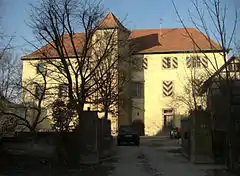Military-sports-group Hoffmann
Military-sports-group Hoffmann (German Wehrsportgruppe Hoffmann (WSG Hoffmann)) was a fascist terrorist gang in the Federal Republic of Germany. Founded by Karl-Heinz Hoffmann in 1973 the group acted as a private armed force with more than 400 active participants. Regarded as the most active neonazi-terrorist gang in the 1970s and 1980s in the Federal Republic, the group was prohibited by the Interior Minister in 1980. Several members of the Wehrsportgruppe Hoffmann were involved in political murders and antisemitic and far-right violence in the following years.
Hoffmann is still active, giving lectures about himself at far-right events and was taking to court journalists, which connected him publicly to the far-right.[1][2]
Foundation
Karl-Heinz Hoffmann is a German trained advertising graphic, born in a small town close to Nürnberg. He grew up in East-Germany and emigrated to West-Germany in the Adenauer-era, driven by strong anti-communist beliefs. In 1973 he founded the so-called "Wehrsportgruppe", German for military-sports-group. At this time several nazi-groups disguised their activities under the guise of military-sports groups.
Early activities

For almost 10 years, the Wehrsportgruppe Hoffmann was able to organise and set up branches nationwide until its prohibition in 1980. The WSH-members acted as security guards at events of far-right parties NPD- and DVU, attacking protesters violently. Later on members trained with weapons and Nazi military vehicles, wearing uniforms similar to the German Bundeswehr.[3]
Hoffmann bought several properties and his girlfriend Franziska Birkmann owned an old castle, Schloss Ermreuth in Bavaria which was planned to be used as a barracks for military exercises. From 1974 his first headquarters was the Schloss Almoshof in Nürnberg and from 1978 Schloss Ermreuth bei Neunkirchen am Brand.[4]
Impact on neo-Nazi terrorism
Hoffmann supported Gundolf Köhler and Axel Heinzmann, a far-right CSU-politician in their plans to establish a Wehrsportgruppe at the university city of Tübingen in the 1970s. On 4 December 1976, an extremely violent attack by neo-nazis against antifascists demonstrators took place at a nazi event in Tübingen with the involvement of Hoffmann, Heinzmann and Köhler.[5]
On September 26, 1980, Gundolf Köhler carried out a bombing on the Oktoberfest in Munich, in which 13 people (including himself) were killed and 211 were injured. German authorities regarded this as the action of a single man and Hoffmann involvement was denied by Bavarian officials.[5]
On 19 December 1980, the Jewish publisher and Rabbi Shlomo Levin and his partner Frieda Poeschke were murdered in Erlangen by an antisemitic murder-plot. Levin had published critical reports about Wehrsportgruppe Hoffmann. The perpetrator of the attack was a member of the WSG Hoffmann: Uwe Behrendt. Behrendt lived at the HQ of WSG Hoffmann and killed Levin and Poeschke with a 9mm Beretta machine gun. Three hours later he came back to Hoffmann and said: "Boss, I shot the chairman of the Jewish community in Erlangen. I did it also for you."[6][7] Hoffmann helped him to cover tracks, burned his clothes and helped him flee to Lebanon.[8]
Influence of the security services
WSG Hoffmann came to the attention of several security services in FRG as well in GDR and other European countries. The state security of GDR Stasi supported some far-right terrorists as agent provocateurs. According to the journalist Regine Igel, the Stasi had a number of far-right activists under contract who were members of Wehrsportgruppe Hoffmann.[9] Also the FRG interior intelligence service had several agents and informants in WSG Hoffmann.
Reception
German politicians in 1980 declared the WSG Hoffmann as a group of "mentally retarded" and "madcaps". The Bavarian Minister for the Interior Gerold Tandler (CSU) relativised the group after its prohibition, claiming that left-wing groups were more dangerous because they had more members and were supported by the communists in Moscow. He was more worried that Hoffmann's group would discredit the reputation of West-Germany abroad.[10]
Der Spiegel wrote in the 2010s that FRG-officials of CDU and CSU had no deeper interest to uncover the connections of Köhler to Hoffmann, because CSU members where also involved in the far-right subculture at this time. Also they wanted to focus more on political violence from the far-left, because this was suited the narrative of conservative politicians during the Cold War.
Literature
- Rainer Fromm: Die „Wehrsportgruppe Hoffmann“: Darstellung, Analyse und Einordnung: ein Beitrag zur Geschichte des deutschen und europäischen Rechtsextremismus. Lang, Frankfurt am Main u. a. 1998.
- Andrea Röpke: Ex-WSG-Chef kauft Rittergut. In: Blick nach rechts. Nr. 9/2004.
- Andrea Röpke, Berny Vogl: Was macht eigentlich …? Karl-Heinz Hoffmann. In: Der rechte Rand. Nr. 84. September/Oktober 2003.
- Patrick Moreau: Les héritiers du IIIe Reich. L’extrême droite allemande de 1945 à nos jours. Paris 1994.
- Ulrich Chaussy: Oktoberfest. Das Attentat. Wie die Verdrängung des Rechtsterrors begann. Ch. Links Verlag, Berlin 2014, ISBN 978-3-86153-757-1.
Weblinks
- Report of Bayerischer Rundfunk in 1980
References
- "Far-right extremist wants not to be referred to as far-right extremist". Süddeutsche Zeitung. Retrieved 13 November 2019.
- Johannes Radke, Toralf Staud (2019-06-19), "Rechter Terror: Rechtsextreme Gruppen laden Hoffmann immer noch zu Vortragsabenden ein", Die Zeit (in German), Hamburg, ISSN 0044-2070, retrieved 2019-06-19
- "Wehrsportgruppe Hoffmann". Amadeu Antonio Foundation. Retrieved 11 November 2019.
- "die bizarre Parallelwelt des Karl-Heinz Hoffmann". Berliner Zeitung. Retrieved 12 November 2019.
- "Im rechten Netz". Der Spiegel. Retrieved 11 November 2019.
- https://www.spiegel.de/spiegel/print/d-13512120.html
- Wolfgang Most: Vereinigung der Einzeltäter: Wehrsportgruppe Hoffmann. haGalil, 3. Januar 2006
- Chef, ich habe den Vorsitzenden erschossen. Spiegel, 47/1984
- Regine Igel: Terrorismus Lügen. Wie die Stasi im Untergrund agierte. Herbig, München 2012, ISBN 3-7766-2698-4, S. 255.
- "Neonazis. Nicht nur Pinsel", Der Spiegel, 4 February 1980 (6), pp. 57–58, 1980